Bathroom Remodel Costs in Illinois 2026 – Guest, Primary & Half Bath Pricing
Bathroom remodel costs in Illinois are influenced by the state’s mix of dense urban housing, aging infrastructure, and wide variation
As with a nice scented candle or finely polished glass, the bathtub is an essential part of completing the look and feel of your bathroom. But whether you are looking for a fancy copper bathtub or more budget material like fiberglass, the size, and shape of your bathtub should be the first question you address.
In 2025, homeowners are split between two major trends in bathtub dimensions: a growing preference for larger, spa-like soaking tubs and a rising demand for compact designs suited for smaller spaces. Freestanding tubs continue to gain popularity, with that segment expected to grow at a 5% CAGR through 2030, driven by interest in wellness and luxury at home. At the same time, urban living is fueling demand for space-saving bathtubs, as more consumers seek comfort without sacrificing square footage. Smart features like automated temperature control and built-in hydrotherapy are also influencing buying decisions across all tub sizes.
In general, standard dimensions will give you a rough figure for the size of the bathtub. However, they all vary depending on the shape and type of bathtub you are looking to purchase.
For a typical standard, wall-wall bathtub, the measures will be roughly 60 inches long, 30-32 inches wide.
Bathtubs come in a wide range of styles and configurations, each with its own typical dimensions to fit different bathroom layouts and user preferences. The table below breaks down standard bathtub sizes by type, including length, width, and height, to help you choose the right fit for your space and design goals.
| Type of Bathtub | Length | Width | Height |
|---|---|---|---|
| Small Alcove Bathtub | 54 inches | 30 inches | 15 inches |
| Alcove Bathtub | 60 inches | 32 inches | 18 inches |
| Drop-in Bathtub | 45 to 72 inches | 30 to 32 inches | 14 to 20 inches |
| Oval Bathtub | 60 inches | 41 inches | 24 inches |
| Whirlpool Bathtub | 60 inches | 32 to 36 inches | 18 to 23-1/4 inches |
| Corner Bathtub | 60 inches | 60 inches | 22 inches |
| Freestanding Bathtub | 55 to 72 inches | 27 to 32 inches | 15 to 20 inches |
| Long Bathtub | 72 inches | 36 inches | 20 inches |
| Japanese Soaking Tub | 40 to 60 inches | 40 to 55 inches | 22 to 30 inches |
| Clawfoot Bathtub | 54 to 72 inches | 30 to 40 inches | 24 to 30 inches |
| Walk-in Bathtub | 48 to 60 inches | 28 to 32 inches | 36 to 40 inches |
| Undermount Bathtub | 45 to 72 inches | 30 to 36 inches | 14 to 20 inches |
| Garden Tub | 60 to 70 inches | 42 to 50 inches | 24 to 30 inches |
| Roman Tub | 55 to 65 inches | 40 to 50 inches | 19 to 24 inches |
| Pedestal Bathtub | 55 to 72 inches | 27 to 32 inches | 22 to 28 inches |
The most common water depth for standard bathtubs is 14 to 20 inches, measured from the bottom of the tub to the overflow drain. While this range works well for everyday use and basic soaking, actual depth can vary depending on the tub’s shape and style. Deeper options—such as soaking tubs or Japanese-style bathtubs—can reach 22 inches or more, offering full-body immersion and a more luxurious bathing experience. When choosing a tub, consider who will be using it and how important deeper soaking is to your comfort.
Now, before we continue any further, there are a few things you should consider before choosing your bathtub. Specifically, how much weight can your floor support and can your water heater handle a larger tub? Will you be looking for a simple remodel or just a replacement for an existing bathtub? Who will be using your tub and more so, ease of access to people in your household? Will it be primarily for cleaning or more for de-stress and relaxation? Answering these questions will help decide the correct dimension of tub that is right for you.
Freestanding tubs are tubs that are unconnected to any walls or surfaces. Depending on the material, freestanding tubs are slightly heavier and are usually distinguishable by the smooth lines and modern design. Freestanding tubs require a rather large bathroom to accommodate the size of the tub as well as the increased weight. If you’re unsure about the size of a freestanding tub and want to learn more about the materials, Badeloft offers FREE bathtub templates and material samples for freestanding bathtubs. Click HERE to request one.
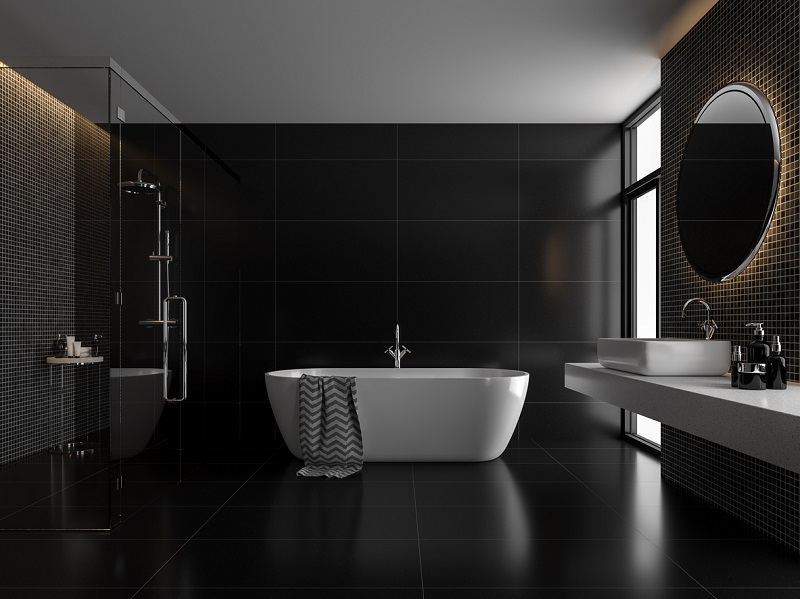
Alcove bathtubs most common bathtub on the market, and what most people consider to be the standard bathtub. Affordable and easy to install, the only drawback is its relatively small size. Alcove bathtubs usually fit within a three wall enclosure, making them ideal for a shower combination as well.
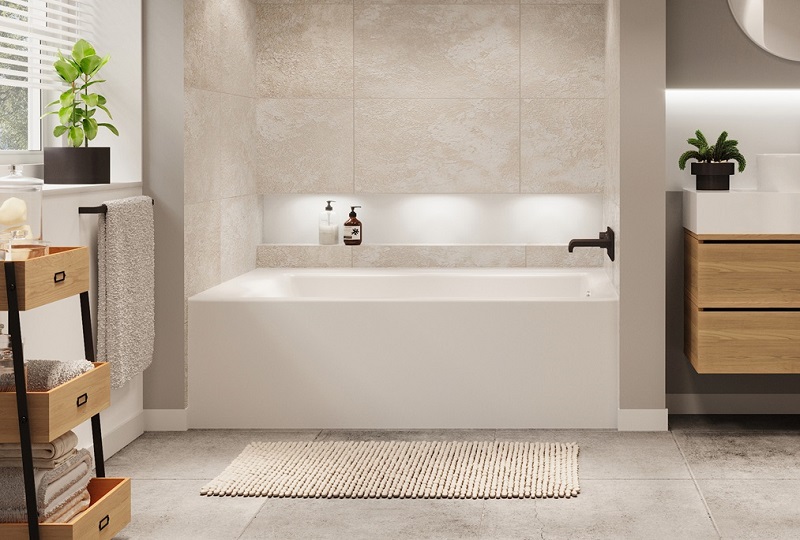
Most bathtubs have a visible finished side, usually called an apron or skirt, which is flat or bowed. Drop in tubs have no finished sides and are usually installed in an alcove or peninsula jutting out in the middle of your bath space. Dimension wise, drop in tubs are similar to the normal standard of bathtubs with slightly more freedom-depending on your space available, you can install in an alcove or in an open area, allowing your dimensions to be both wider and longer compared to an alcove bathtub.
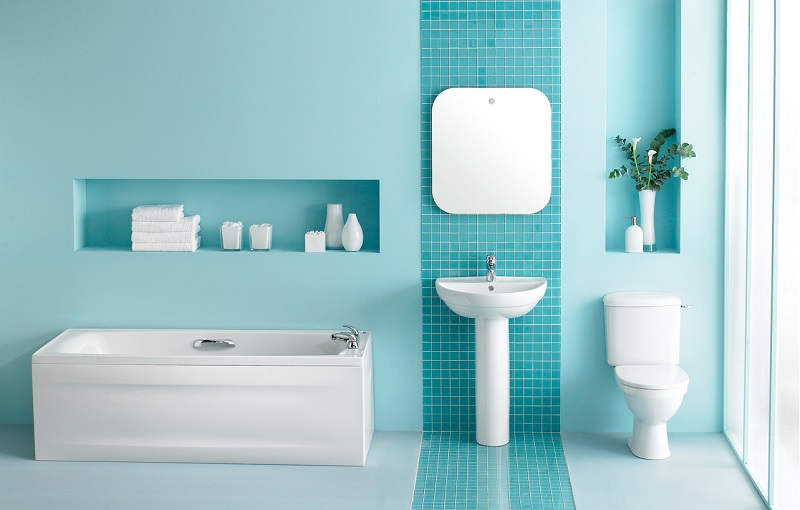
Almost identical to a drop in bathtub, except its rim is covered in a small deck top made of stone or tile which will usually obscure the rim during installation. The stone and tile surround offers a more pleasant aesthetic compared to a drop in tub, but do keep in mind that you pay for that luxury.
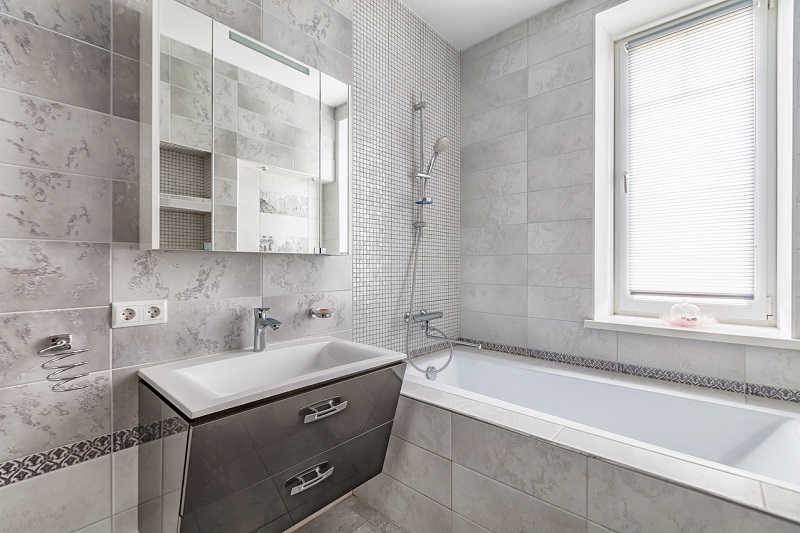
Luxury first, corner bathtubs generally are not used for normal bathing. Corner tubs are usually installed in master bathrooms and are ideal for de-stress, meditation, and calming soaks. The design is also different, as it is shaped closer to a triangle than the typical rectangle of a normal bathtub.
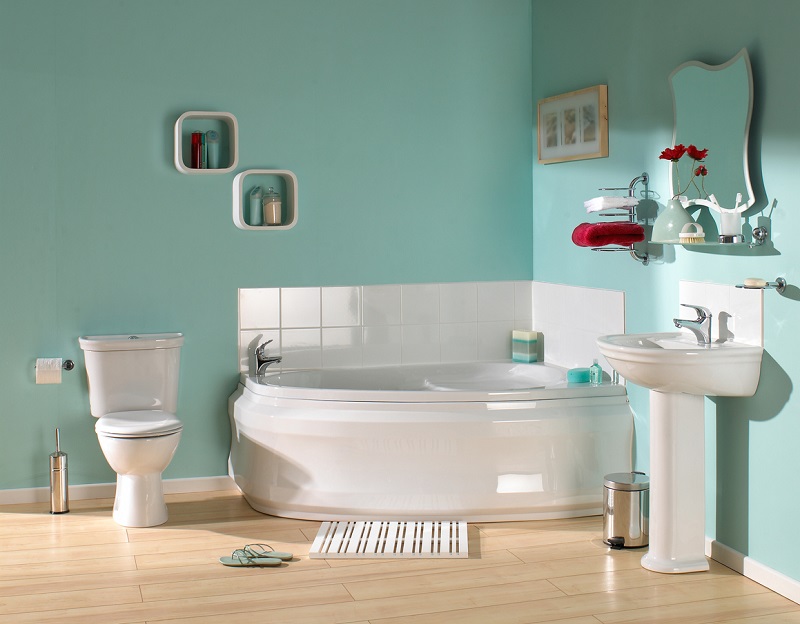
For those with mobility issues or many senior residents, the walk-in baths are a great option. A walk in bathtub is a bathtub that is elevated higher, with a door on the side that allows you to walk in and sit in your bathtub. This, of course, means that slippage or any accidents that happen in the shower will lessen as there are special handrails and grips designed to keep your head above the water and to ease you in and out of the bathtub itself.
The downside, of course, is that most walk-in bathtubs will require professional installation. Also, since the water does not flow unless you are standing inside of it, they tend to create a heavy drain on your water heater as you wait for the large tub to fill with water before coming to temperature.
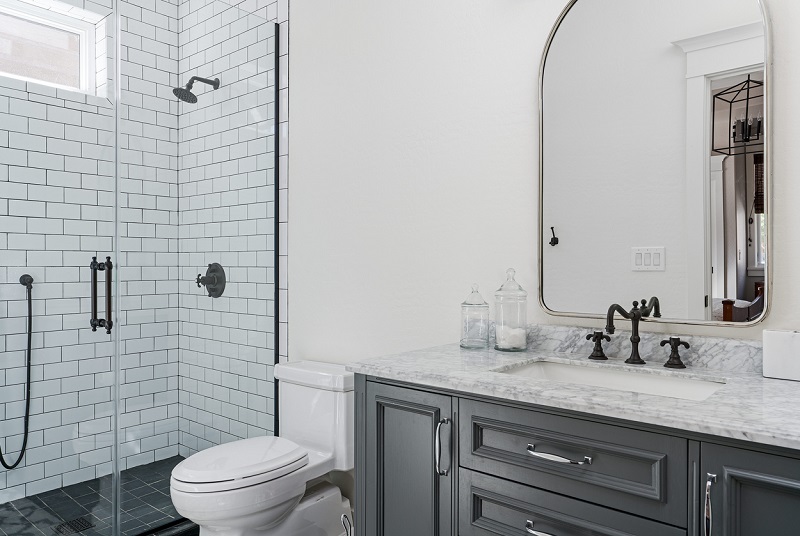
So now that you are familiar with the dimensions of your bathtub, it is essential to understand the size of your bathtub in water volume. This will help you decide what size bathtub is appropriate for you and understand how fast your bathtub will fill and how much water it will use.
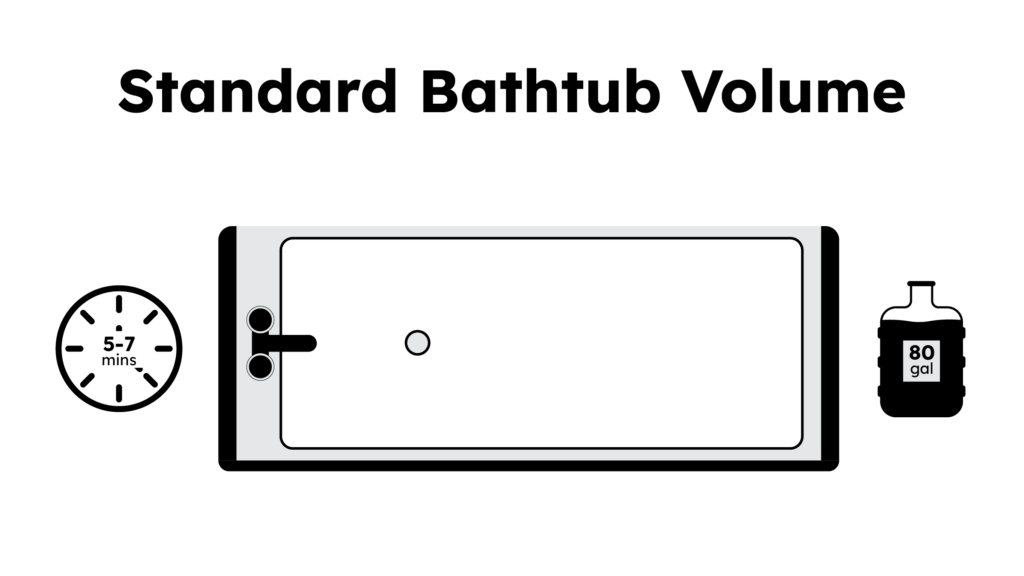
A standard bathtub holds around 80 gallons of water and takes roughly 5–7 minutes to fill up. Understanding bathtub water capacity is important as this style of bathtub is the standard variant for a reason. It holds a large amount of water and fills up quickly, making it practical for daily use. Most standard tubs are designed to be spacious enough for comfortable soaking while still fitting within typical bathroom layouts. However, because they have a wider, shallower design compared to deeper soaking tubs, the water tends to cool more quickly—often requiring users to add more hot water to maintain a comfortable temperature. This can lead to increased water and energy usage over time, especially in colder climates or drafty bathrooms.

A freestanding bathtub can hold 90-100 gallons of water and take 7-15 minutes to fill. The primary benefit of this style and volume is that individuals can submerge themselves, bringing numerous health benefits. In addition, freestanding bathtubs are constructed from materials that trap heat, resulting in a more comfortable bathing experience. However, their downside is that it takes longer to fill up and weighs significantly more than other bathtubs, meaning floor reinforcement is crucial.

If you are looking for something between a standard bathtub and a freestanding, there are non-traditional designs. For example, some designs can hold just 70 gallons of water, whereas some can hold up to 120 gallons. The primary advantage of these bathtubs is that their unique design gives them a wide range of functionality in any home. Japanese Soaking bathtubs are an example of this, holding a low volume of water while having a quick fill time. The drawback to these bathtubs is that their unique design may also require more space than traditional bathtub designs.
There are many considerations one should take as they think about the amount of water a bathtub can hold. Standard bathtub usage can impact the following considerations.

We all enjoy having a relaxing bath, but using 70-120 gallons of water is not financially and environmentally sound. When it comes to overall water usage, we should limit baths to at least once a week to not tax our region’s water supply or increase your water bill.
A big bathtub is a relaxing fixture in any bathroom, but consider that the larger the bathtub, the more maintenance and care it requires. For example, a large bathtub will need to be maintained at least once a week due to the increased size, whereas a smaller bathtub will need to be maintained every two weeks.
Remember that a bathtub is quite large and is not an appropriate fit for all bathroom sizes, so consider where you add your bathtub carefully. Ensure that the volume and weight of the bathtub is appropriate for your home and that the fill time makes sense for its location.
Filling a bathtub—especially a larger or deeper model—requires a substantial amount of hot water, which places a greater demand on your water heater. Most standard water heaters have a capacity of 40 to 50 gallons, which may not be enough to fill a larger tub with hot water in one go. If you’re installing a high-volume bathtub, you may need to upgrade your water heater or consider on-demand systems to ensure consistent hot water availability without driving up energy costs.
Water is heavy—roughly 8.34 pounds per gallon—so a full bathtub can add hundreds of pounds of additional weight to your bathroom floor. When choosing a high-volume or extra-deep tub, especially on upper floors, it’s crucial to evaluate whether your home’s structure can support the weight of the tub, water, and occupant combined. Consulting a contractor or structural engineer before installation can help prevent long-term damage or safety issues.
Each style of bathtub offers a wide variety of sizes to fit your specific bath space, including bathtubs for small spaces. Carefully consider the proper dimensions against the size of your bathroom and ultimately decide what kind of use this bathtub will see. In short, be practical and you will surely find the right bathtub.

Eric is the founder and president of Badeloft USA. He has been the president of Badeloft’s US division for over ten years and oversees all marketing and branding aspects of Badeloftusa.com.
His expertise lies in small business development, sales, and home and bathroom industry trends and information.
Contact us with any business related inquiries.
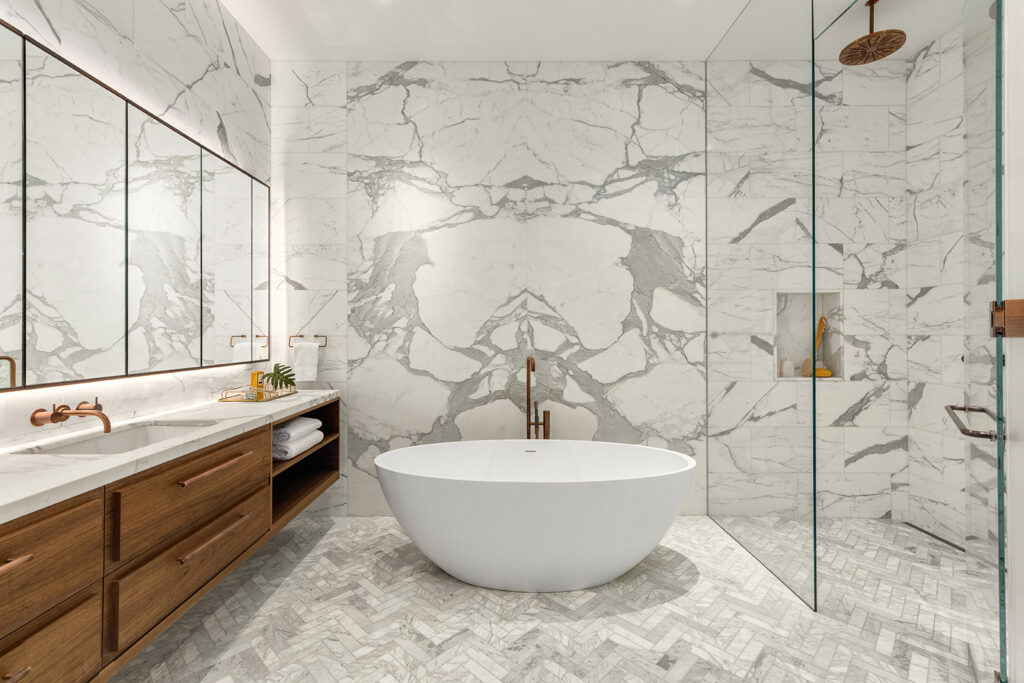
Free material samples and tub templates
Bathroom remodel costs in Illinois are influenced by the state’s mix of dense urban housing, aging infrastructure, and wide variation
Bathroom remodel costs in Pennsylvania are shaped by the state’s older housing stock, diverse regional economies, and wide variation between
Bathroom remodel costs in Ohio are shaped by the state’s older housing stock, moderate labor rates, and significant variation between
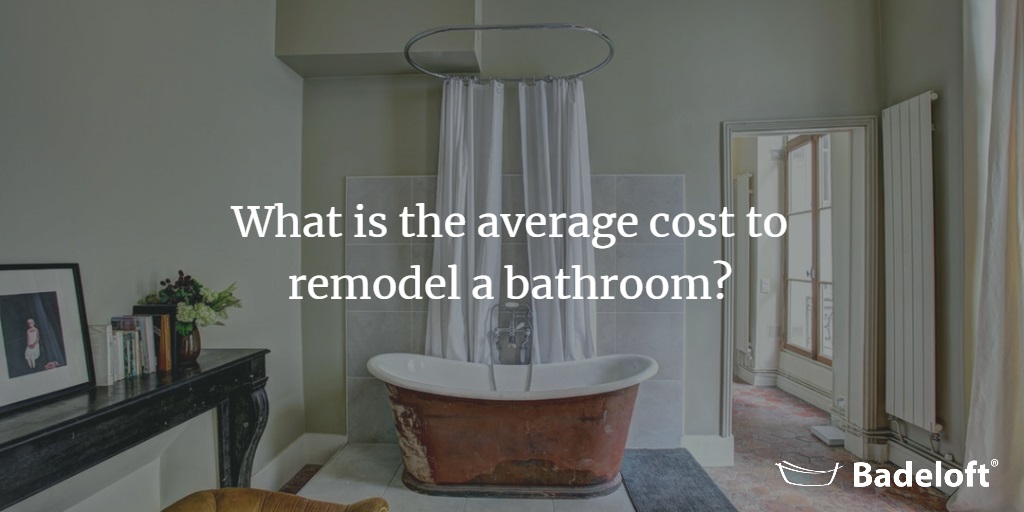
Remodeling a bathroom breathes new life into your home, turning a functional space into a comfortable and relaxing retreat—but it
"*" indicates required fields
"*" indicates required fields
Request your free material sample below. By submitting, you agree to receive occasional product updates and offers from Badeloft. Unsubscribe anytime.
"*" indicates required fields
Remodeling bathroom for 60ish couple
At what age do these tubs usually become a problem?
Is there a 58 “ long bathtub
Yes, we have a 58″ tub here: https://www.badeloftusa.com/product/freestanding-bathtub-bw-01-s/
How to determine the best length freestanding tub based on height? I’m 5’1”, but husband is 6’. I think I need to touch the tub end to feel comfortable.